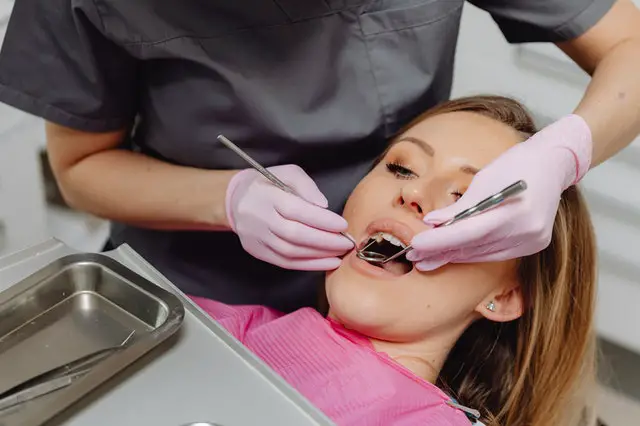If you’re in the middle of getting root canal treatment, you may be facing multiple trips back and forth to your dentist between appointments and procedures. So, should you consider flying between root canal appointments?
This can make flying complicated. It is true, particularly if your dentist doesn’t have an office in or near the airport you fly into or out of regularly. In this article, I’ll get you covered on how to plan trips while having root canal appointments and give you tips on booking flights when you have these appointments. I hope by having some idea about these you can stay comfortable and safe during your travels.
Table of Contents
The dentist thinks you should fly
Flying is not a problem in most cases. Still, you must be you’re willing to sit still for a while after landing.
After having a root canal, your mouth will probably be sore, and some swelling may occur. But as long as you aren’t starting any new medications or otherwise changing your treatment plan during your flight, flying won’t affect how quickly you heal.
Talk to your dentist if you have concerns about flying after a root canal. He or she can help determine whether it’s safe for you to travel. Most likely, your dentist will say that there are no reasons why you shouldn’t fly, even just after the root canal. Some Doctors will be a bit conservative, though.
Just remember to take some prescribed painkillers before your flight; it should help reduce swelling and pain.
It’s also important to stay hydrated by drinking plenty of water. If you experience increased swelling or bleeding while on your trip, contact your dentist immediately upon arrival.
It could mean that something is wrong with your tooth, or just that you haven’t eaten enough food, since eating isn’t recommended right after a root canal procedure.
Either way, let your dentist know what happened. so he or she can assess what needs to happen next.
What should be the waiting time between root canal appointments
4 or 5 days? Six days? Weeks?
What’s a reasonable amount of time to wait between root canal appointments in order to reduce the risk of complications and ensure a speedy recovery?
It turns out that there are no easy answers.
Dentists have different opinions on what constitutes an acceptable waiting period before returning to their offices for another round of root canal therapy.
Some believe that it’s perfectly fine to return after only four days, while others prefer to see their patients at least twice as long before reopening up their mouths.
And if you ask two different doctors, you’ll likely get two very different answers.
In general, most respondents recommended a waiting period of 1 to 3 weeks between root canal treatments. A handful said 2–3 weeks was sufficient, but most preferred to see patients every month or even every other month following treatment, especially if additional work was needed.
What happens between root canal appointments?
Once your dentist has finished working on your teeth, and you’ve made it through recovery, you’ll have to wait for a period of time for healing to take place.
With that wait can come to a lot of questions
Are you supposed to eat anything or avoid certain foods?
When can you fly?
Will it hurt when you floss?
Or, what about your teeth, will they become loose or even fall out if you don’t visit your dentist regularly enough?
These are all valid concerns.
Here’s what you need to know before traveling during root canal recovery. The next appointment after the root canal is all about filling the exterior with the infected tooth and also sealing the disease-free space. Dentist may also provide some medication to use to stop the bacteria from coming back.
Flying with Teeth in Pain
Although many people travel with a temporary filling in their mouth following treatment, others may opt to leave their tooth empty until after their trip is over.
It’s important to talk with your dentist about how long you should wait between treatment and flying so that he or she can help determine whether any additional precautions are necessary.
In general, patients who are instructed to keep their teeth empty should not fly for at least 24 hours after treatment.
If you’re not sure which option is best for you, discuss your flight plans with your dentist. If you can’t wait 24 hours and leaving your tooth empty isn’t an option, try taking an over-the-counter pain reliever before boarding your flight.
Be sure to bring extra medication with you just in case!
Should you consider taking rest after a root canal appointment
Sure, root canals are no laughing matter.
But after your procedure, you may be tempted to take a short vacation while your mouth heals and do some sightseeing before returning to your normal routine.
Before you start planning that trip though, talk with your dentist.
While most people are able to go about their normal daily activities (including flying) as soon as their appointment is over, others should avoid strenuous activity for a few days or weeks.
It would depend on how extensive their treatment was and what type of anesthesia they received.
So, if you’re looking to fly between root canal appointments, it’s best to check in with your dentist first. He or she will give you advice based on your individual case and let you know whether it’s safe for you to travel.
Should you consider a root canal appointment as an emergency?
If you have a tooth ache, you may have considered trying to get an appointment with your dentist as soon as possible.
Many people will see a regular medical doctor in such situations and think nothing of it. Yet many do not consider seeing a dentist in such situations to be an emergency.
However, if you are suffering from tooth pain, root canal appointments can be just as important to make on short notice.
You should make sure that you don’t wait too long before getting in touch with your dentist about any dental issues that might come up.
By scheduling an appointment for a time when you won’t be able to travel, you could find yourself needing more than one trip to deal with your toothache.
This is especially true if there is a chance that surgery or other major procedures will need to take place at some point during treatment.
As such, it is vital that you try to get in touch with your dentist as quickly as possible, so they can help relieve any pain or discomfort associated with what could be an infected or damaged tooth.
Should you be concerned about radiation from flights?
Radiation on airplanes is an issue that many people are concerned about, but most of those fears are misplaced.
There are three kinds of radiation to be aware of.
Cosmic rays
While cosmic rays exist in low levels everywhere on Earth, their impact depends on altitude, the higher you go, the more powerful they become.
The atmosphere protects us somewhat from cosmic rays, though once you’re flying at 33,000 feet in a commercial aircraft there isn’t much protection left.
Some studies have shown that flight attendants and frequent fliers may have a slightly increased risk of developing cancer because of cosmic rays.
Ionizing radiation
This type comes from radioactive substances like uranium and radon gas, which can enter your body through inhalation or ingestion.
However, ionizing radiation is only found in flicker amounts inside airplanes; even if it were present in larger quantities, it wouldn’t pose a health risk since your skin and other bodily tissues act as natural shields against such exposure.
Non-ionizing radiation
Non-ionizing radiation includes visible light such as sunlight and radio waves like those used by cell phones. Non-ionizing radiation doesn’t penetrate deeply into human tissue, so you don’t need to worry about non-ionizing forms of radiation while flying.
Overall, flights aren’t a major source of harmful radiation exposure for most people. So, there is no chance of having issues due to radiation on the plane after doing a root canal. Just remember to wear sunscreen during long flights, so you don’t get burned!
How long will your tooth hurt after a root canal appointment?
On a pain scale of 1 to 10, your tooth will likely be a 7 or 8 immediately after your procedure.
But how long will it stay that way?
The answer depends on several factors, including what type of anesthesia you receive and whether you get a root canal in one visit or over multiple visits.
It also depends on how well you take care of yourself post-procedure. Here’s what you can expect, If your dentist performs all steps in one visit, removing infected tissue from inside your tooth and filling it with a biocompatible material, then you may experience some lingering discomfort for up to three days.
How can you lessen the pain after a root canal?
To relieve pain, you can take over-the-counter pain relievers. You should also avoid chewing on that side of your mouth until you’re feeling better.
It’s also important to remember that you might feel sore even if you don’t have any exposed nerves left in your tooth. Postoperative soreness is common after any dental procedure, and it should go away within a few days or weeks.
But there are several things you can do to speed recovery along. Drink plenty of water to keep your mouth hydrated. Eat soft foods like yogurt, applesauce, scrambled eggs, ice cream, and pudding if you don’t normally eat these foods.
Using an electric toothbrush, chewing sugarless gum frequently also brushing too hard or using hard-bristled brushes could cause damage during recovery.
When is it safe to fly after a root canal?
After your root canal appointment, it’s important to give your mouth a break from any additional tooth-grinding or biting pressure. Because flying involves both of these, you should not fly for at least 24 hours after treatment.
If possible, wait a few days longer before hitting the skies to allow for swelling and sensitivity to subside.
You can reduce pain by taking over-the-counter pain relievers as I have already mentioned.In addition, avoid alcohol while recovering, alcohol increases blood flow to your gums and may cause them to swell.
It’s also a good idea to bring along an extra pair of soft bite guards in case your dentist has placed temporary ones in your mouth during treatment. This way, if you experience discomfort on board, you can switch out with fresh ones without having to worry about others noticing that something is wrong with your smile!
When traveling long distances, be sure to drink plenty of water to stay hydrated.
As always, call your dentist if you have any questions or concerns about when it’s safe to fly after receiving dental care.
How long before my flight should I get my tooth filled?
While it can take up to two weeks for a tooth to fully seal after a root canal, you shouldn’t get your tooth filled until that time has passed.
This way, you don’t risk any secondary infections while traveling.
However, if you do have a preexisting infection in your mouth or if it takes longer than two weeks for your tooth to seal after root canal treatment, contact your dentist and airline before. By doing so, they can determine whether you need any special precautions.
Some airlines will not allow you to fly with an infected tooth, even if it is only partially sealed.
If you’re still unsure about when to get your tooth filled after root canal treatment, talk with your dentist about when he recommends filling your tooth.
This way, you can make sure you give yourself enough time between getting treated and leaving on a vacation or a business trip.
Flying with a temporary crown
Though it may seem strange, flying with a temporary crown is possible, but you have to follow some precautions.
Prior to boarding your flight, schedule an appointment with your dentist to ensure that any temporary crown is properly seated.
If it becomes loose or falls out, you should see a dentist immediately upon landing.
Once at your destination, see a dentist immediately if you experience any pain or symptoms of swelling. You’ll also want to be sure not to chew gum or eat sticky foods while traveling.
To avoid having food get stuck in your mouth, bring along plenty of soft and easy-to-chew snacks.
It’s also important to avoid drinking through a straw while eating, since sucking can loosen teeth and cause problems with chewing and swallowing.
Finally, stay careful when brushing your teeth on board, if you feel discomfort or notice blood in your mouth after brushing, stop immediately and consult a dentist when you land.
How will I know if I have gum problems from the plane trip?
A dentist will be able to tell you if you have gum issues from your trip after inspecting your teeth and gums, but in most cases, it will not be severe enough to worry about.
After all, many of us fly every week for work and never experience issues related to our dental health.
In rare cases, however, flying can put enough pressure on our jaws and lips that there is noticeable damage.
This is especially true for people who are already at risk of developing gum disease or other oral issues.
For example, individuals with untreated tooth decay or a history of periodontal disease may find their symptoms worsen after a long flight.
However, it’s important to remember that these kinds of issues usually take months or years to develop, it’s unlikely you’ll notice any changes immediately following a flight.
If you do experience pain or discomfort after a plane ride, make an appointment with your dentist as soon as possible.
What are other reasons for not flying soon after your procedure?
Next time you’re headed to a root canal appointment, think twice before you book your flight.
While flying after getting a root canal is generally safe, there are some risks that may make it advisable to delay your trip.
Waiting to fly until you no longer feel any pain from your root canal procedure is not enough. Other factors must be considered, such as taking medication for pain.
If you are required to take antibiotics before flying because of your procedure, make sure that it has been at least 6-8 hours after taking them before trying to fly.
You may also experience dizziness and nausea if you are dehydrated or exhausted following your flight. Fatigue and dehydration make air sickness more likely to occur when flying. The best way to avoid these issues is by staying hydrated during your trip and keeping a healthy diet.
You should also try to keep yourself busy so that you do not become bored while waiting in airports or on planes. To help with fatigue, try listening to music or watching a movie on your phone/tablet; these activities will help distract you from feeling tired.
The information in this post does not replace consultation with your dentist or physician. If you have concerns about flying soon after receiving treatment, contact your doctor or dentist.
Will I feel pain during the flight?
It is possible that you may feel some discomfort during your flight.
Some of your medications can cause drowsiness, which may affect your flying experience. Many airlines do not allow you to fly while on strong pain medications. For better results, consider switching to some light prescribed painkillers before flying.
The most important thing is to take your medication regularly, as prescribed by your dentist. If you have any questions about taking pain medications before or during a flight, contact your dentist or pharmacist.
Can you speak during the flight after having a recent root canal?
If you recently got a root canal, there are two important questions to ask your dentist: Can I fly now? And can I speak during flight? Some people can experience extreme pain or discomfort after a root canal. Ask your dentist if you need additional meds in case you start to feel uncomfortable during flight.
You may wonder whether or not you should be able to speak during a flight after a root canal. After all, talking during your flight will keep you distracted from your tooth pain.
However, it’s important to check with your dentist first. Many dentists recommend that their patients avoid talking on long flights after having a root canal.
The reason is because being in an upright position while traveling can cause pressure on your mouth and face, which can lead to additional pain and discomfort.
If you do have a recent root canal, try to sleep as much as possible during your flight.
Sleeping helps reduce swelling and pain caused by air travel.
Also, while traveling with a recent root canal, trying not to sleep may work for some people. This is good advice for anyone prone to airsickness anyway, sleeping tends to exacerbate nausea and vomiting.
Instead, take advantage of being awake to read, listen to music or watch a movie. Be aware that you might feel more tired than usual, so save some good movies or music for your flight. Also, if you know you’re prone to airsickness or motion sickness, try to sit near a window, so you can look out into space during take-off and landing. It will help your brain feel more grounded.
How can you take care of your teeth after a root canal?
There are a few ways you can take care of your teeth after a root canal.
First, and most important, is to schedule regular dental checkups to monitor your progress.
During these visits, your dentist will look for signs of new decay or infection and make any necessary adjustments to treatment. In addition, there are several other steps you can take at home to keep you on track after a root canal treatment once you have healed.
Brush twice daily with an electric toothbrush
Floss once daily
Use mouthwash as directed by your dentist
Visit your dentist regularly for cleanings
These simple measures can help you maintain a healthy smile.
Tips for flying with Teeth Issues
If you’re taking a trip and have recent or pending dental work, make sure to do some planning ahead of time.
You don’t want to find yourself in an uncomfortable situation! To ensure that you need to follow some tips, I am going to mention them in this blog.
Pack painkillers
You need to take prescribed painkillers by the dentist. You also need to make sure there is no side effect related with those.
Carrying numbers
Carry important numbers, including those of your dentist, your medical insurance company, your airline, and anyone else involved with your dental appointments/surgery/procedure.
Printing out important papers
Print out copies of all relevant paperwork for instance, insurance cards, prescriptions, and any other documents that might be required at check-in or while traveling.
Keep soft foods
Pack soft foods that are easy to eat on a plane, like yogurt and granola bars. A good rule of thumb is not to bring anything that requires cutlery like sandwiches as it can be difficult to eat on planes without spilling food everywhere!
Pick window seat
Choose window seats if possible, being able to prop up your head makes sleeping much easier.
Taking breaks
Take frequent breaks from reading, working on a laptop or watching movies by stretching and doing gentle exercises such as neck rolls and shoulder shrugs. These will help reduce muscle tension caused by sitting for long periods of time.
Comfortable clothing
Wear loose clothing, so you’ll be comfortable even if you need to change clothes during your flight. Some people also recommend wearing layers, so you can easily adjust your temperature throughout your journey.
Bringing tissues
Bring tissues with you in case there isn’t a tissue box available on board.
Bringing personal traveling stuff
Consider bringing earplugs and eye masks to help block out noise and light respectively, many airlines provide these items, but they often run out quickly, especially if there are delays or disruptions.
You must remember, no matter how uncomfortable flying maybe, think positively!
It won’t last forever.
Frequently asked questions (FAQs)
How soon after my procedure should I fly?
The ideal time frame for flying after getting a root canal varies depending on your dentist’s instructions. For example, in some cases, you may be told not to fly for 24 hours. In others, 48 hours.
Are there any other medications I shouldn’t take while flying?
Some painkillers contain aspirin, which can irritate your stomach if taken with certain over-the-counter and prescription medications. If you are taking any of these, check with your doctor to see if they will make you sick while flying.
Are there any other steps I should take to ensure my flight is safe?
If you have a root canal, be sure to bring some painkillers with you in case of an emergency. If you are nervous about flying after getting a root canal, talk with your dentist about how best to prepare for your trip.
Wrapping things up
Although traveling with a toothache can be a pain, having to deal with root canal surgery is much worse. The good news is that, even in extreme cases such as flying between root canal appointments, there are ways to make your experience as painless as possible.
With proper precaution and preparation, you can easily get from point A to point B without much discomfort at all.
Best of luck!






